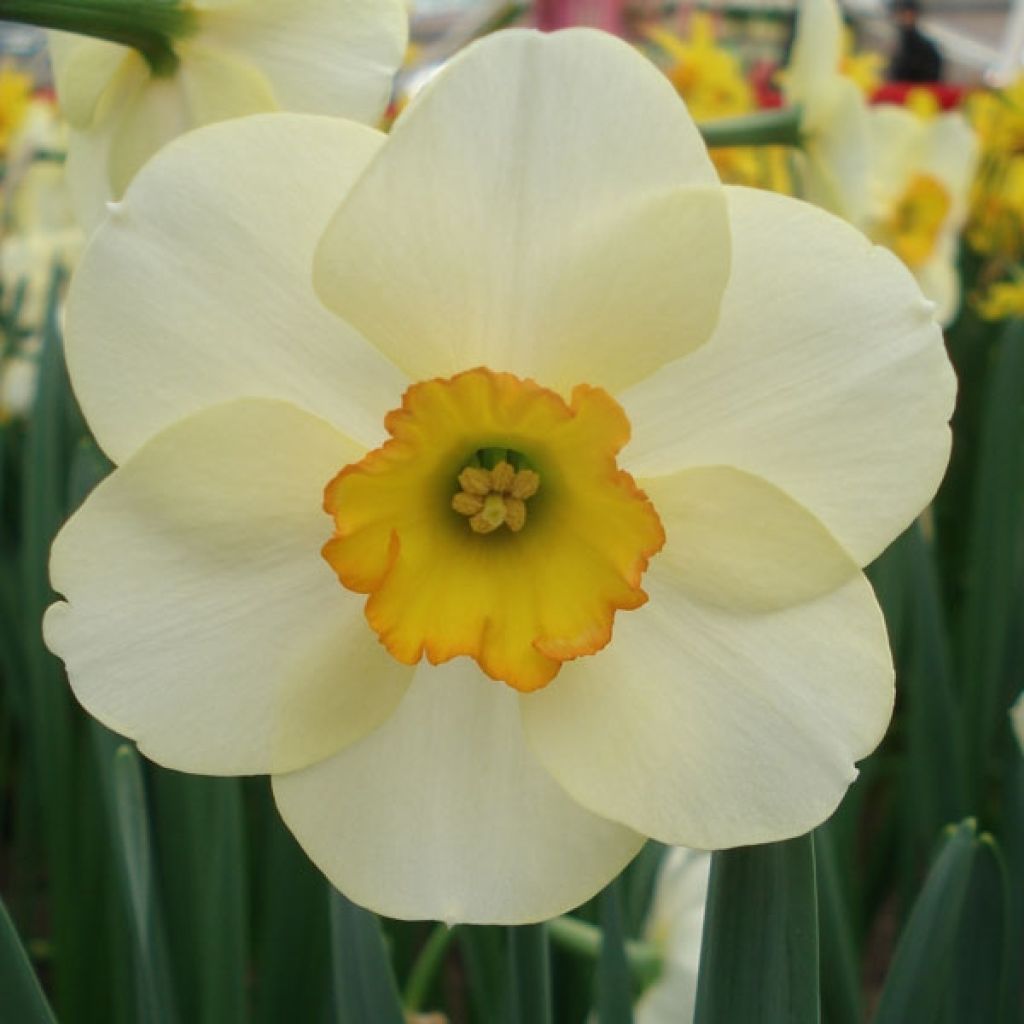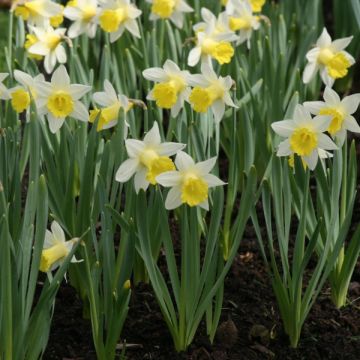

Narcisse Ringtone
Narcissus 'Ringtone'
Narcissus Ringtone
Daffodil, Narcissus, Jonquil
I look forward to discovering them." Analyse de la traduction : La traduction est correcte et transmet le sens du texte original. Il n'y a pas de fautes d'orthographe, de grammaire ou de structure. Le ton du texte est conservé.
Marie-Christine, 15/11/2022
Special offer!
Receive a €20 voucher for any order over €90 (excluding delivery costs, credit notes, and plastic-free options)!
1- Add your favorite plants to your cart.
2- Once you have reached €90, confirm your order (you can even choose the delivery date!).
3- As soon as your order is shipped, you will receive an email containing your voucher code, valid for 3 months (90 days).
Your voucher is unique and can only be used once, for any order with a minimum value of €20, excluding delivery costs.
Can be combined with other current offers, non-divisible and non-refundable.
This plant carries a 6 months recovery warranty
More information
We guarantee the quality of our plants for a full growing cycle, and will replace at our expense any plant that fails to recover under normal climatic and planting conditions.

Would this plant suit my garden?
Set up your Plantfit profile →
Description
Narcissus 'Ringtone', warm and full of good humor, offers a large flower in April composed of a pale yellow perianth at first, fading over the days, and featuring a wide and short crown, very flared, of a brighter yellow, all festooned with orange. This recently obtained variety is already a sure value: faithful, easy to cultivate, prolific and floriferous, it also stands out for the sweet, sugary scent of its flowering.
Native to Western Europe, the narcissus belongs to the Amaryllidaceae family. The Narcissus genus includes numerous species and varieties, of botanical origin (such as Narcissus poeticus) or horticultural. The jonquil (Narcissus jonquilla), with yellow flowers and leaves similar to those of the rush, is one of the species in the Narcissus genus. In some regions, the yellow narcissus or trumpet narcissus (Narcissus pseudonarcissus) is sometimes called jonquil, hence the frequent confusion between jonquil and narcissus.
Narcissus 'Ringtone', obtained in 2009 from unknown parents, was introduced to the horticultural market in 2015. Its sweet, sugary scent and its small crown suggest that it possesses the genes of Narcissus poeticus, a botanical species that grows spontaneously in nature, particularly in alpine meadows. It is a bulbous plant with slightly pointed linear leaves, slightly bluish-green in colour. The hollow stems, 40-50cm (16-20in) long, end in simple flowers, 9.7cm (4in) wide, with 6 wide undulate petals of pale yellow, finishing off white ivory. In the centre is a small crown, 1.4cm (1in) long, fringed at the edge, of a bright yellow marginally bordered with orange. This variety will bloom mainly in April, depending on the climate.
Easy to cultivate and very hardy, Narcissus 'Ringtone' can be planted in various places in the garden: in the foreground of a shrub bed, along a border, in the middle of a short grass meadow, or can be grown in a pot. It pairs beautifully with grape hyacinths, early tulips, hyacinths, and easily naturalizes. However, be careful with young children, as the bulb, flower, and leaves are toxic. Narcissus are the most resistant bulbs planted in autumn, they prefer well-drained and light soil but are very accommodating.
For bouquets: We advise against mixing Narcissus with other flowers, especially tulips. The stems of Narcissus contain a substance that quickly wilts other flowers. This harmful effect on other types of flowers can be mitigated by dipping the ends of the narcissus stems in hot water for 1 to 2 minutes.
Report an error about the product description
Plant habit
Flowering
Foliage
Botanical data
Narcissus
Ringtone
Amaryllidaceae
Daffodil, Narcissus, Jonquil
Cultivar or hybrid
Other Single Daffodils
View all →Planting and care
Place the Daffodils in full sun or partial shade. Very easy to grow, they can tolerate both the shade of a woodland and a sunny flower bed. They prefer moist but well-drained soils. Plant them in autumn, 15cm (6in) deep and spaced 10cm (4in) apart. Group them in minimum clusters of 5 bulbs, in uniform or mixed colours. You can plant them in the short grass meadow. In this case, lift the turf, dig and loosen the soil to a depth of at least 20cm (8in) (the length of a spade). Plant your bulbs, cover with soil and replace the turf. Choose a spot where you won't mow, as it is necessary to let the daffodil leaves wither before cutting them. This is when the bulb rebuilds itself and prepares the flowers for the following year. However, remember to cut the flowers as soon as they have faded to prevent seed formation. This would unnecessarily deplete the bulb. Also, cut the leaves when they have turned yellow and apply fertilizer at that time, not before. Maintain regular watering during growth and then let the soil dry out once the foliage is mature.
Planting period
Intended location
Care
-
, onOrder confirmed
Reply from on Promesse de fleurs
Haven't found what you were looking for?
Hardiness is the lowest winter temperature a plant can endure without suffering serious damage or even dying. However, hardiness is affected by location (a sheltered area, such as a patio), protection (winter cover) and soil type (hardiness is improved by well-drained soil).

Photo Sharing Terms & Conditions
In order to encourage gardeners to interact and share their experiences, Promesse de fleurs offers various media enabling content to be uploaded onto its Site - in particular via the ‘Photo sharing’ module.
The User agrees to refrain from:
- Posting any content that is illegal, prejudicial, insulting, racist, inciteful to hatred, revisionist, contrary to public decency, that infringes on privacy or on the privacy rights of third parties, in particular the publicity rights of persons and goods, intellectual property rights, or the right to privacy.
- Submitting content on behalf of a third party;
- Impersonate the identity of a third party and/or publish any personal information about a third party;
In general, the User undertakes to refrain from any unethical behaviour.
All Content (in particular text, comments, files, images, photos, videos, creative works, etc.), which may be subject to property or intellectual property rights, image or other private rights, shall remain the property of the User, subject to the limited rights granted by the terms of the licence granted by Promesse de fleurs as stated below. Users are at liberty to publish or not to publish such Content on the Site, notably via the ‘Photo Sharing’ facility, and accept that this Content shall be made public and freely accessible, notably on the Internet.
Users further acknowledge, undertake to have ,and guarantee that they hold all necessary rights and permissions to publish such material on the Site, in particular with regard to the legislation in force pertaining to any privacy, property, intellectual property, image, or contractual rights, or rights of any other nature. By publishing such Content on the Site, Users acknowledge accepting full liability as publishers of the Content within the meaning of the law, and grant Promesse de fleurs, free of charge, an inclusive, worldwide licence for the said Content for the entire duration of its publication, including all reproduction, representation, up/downloading, displaying, performing, transmission, and storage rights.
Users also grant permission for their name to be linked to the Content and accept that this link may not always be made available.
By engaging in posting material, Users consent to their Content becoming automatically accessible on the Internet, in particular on other sites and/or blogs and/or web pages of the Promesse de fleurs site, including in particular social pages and the Promesse de fleurs catalogue.
Users may secure the removal of entrusted content free of charge by issuing a simple request via our contact form.
The flowering period indicated on our website applies to countries and regions located in USDA zone 8 (France, the United Kingdom, Ireland, the Netherlands, etc.)
It will vary according to where you live:
- In zones 9 to 10 (Italy, Spain, Greece, etc.), flowering will occur about 2 to 4 weeks earlier.
- In zones 6 to 7 (Germany, Poland, Slovenia, and lower mountainous regions), flowering will be delayed by 2 to 3 weeks.
- In zone 5 (Central Europe, Scandinavia), blooming will be delayed by 3 to 5 weeks.
In temperate climates, pruning of spring-flowering shrubs (forsythia, spireas, etc.) should be done just after flowering.
Pruning of summer-flowering shrubs (Indian Lilac, Perovskia, etc.) can be done in winter or spring.
In cold regions as well as with frost-sensitive plants, avoid pruning too early when severe frosts may still occur.
The planting period indicated on our website applies to countries and regions located in USDA zone 8 (France, United Kingdom, Ireland, Netherlands).
It will vary according to where you live:
- In Mediterranean zones (Marseille, Madrid, Milan, etc.), autumn and winter are the best planting periods.
- In continental zones (Strasbourg, Munich, Vienna, etc.), delay planting by 2 to 3 weeks in spring and bring it forward by 2 to 4 weeks in autumn.
- In mountainous regions (the Alps, Pyrenees, Carpathians, etc.), it is best to plant in late spring (May-June) or late summer (August-September).
The harvesting period indicated on our website applies to countries and regions in USDA zone 8 (France, England, Ireland, the Netherlands).
In colder areas (Scandinavia, Poland, Austria...) fruit and vegetable harvests are likely to be delayed by 3-4 weeks.
In warmer areas (Italy, Spain, Greece, etc.), harvesting will probably take place earlier, depending on weather conditions.
The sowing periods indicated on our website apply to countries and regions within USDA Zone 8 (France, UK, Ireland, Netherlands).
In colder areas (Scandinavia, Poland, Austria...), delay any outdoor sowing by 3-4 weeks, or sow under glass.
In warmer climes (Italy, Spain, Greece, etc.), bring outdoor sowing forward by a few weeks.

































